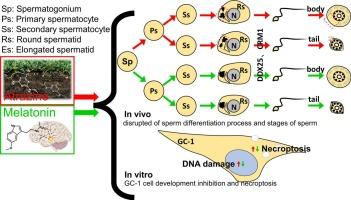褪黑素可保护生精细胞免受阿特拉津诱导的 DNA 损伤和坏死作用的影响
IF 4.2
1区 农林科学
Q2 BIOCHEMISTRY & MOLECULAR BIOLOGY
引用次数: 0
摘要
阿特拉津(ATZ)是一种广泛使用的三嗪类除草剂,已被证明会破坏生物的生殖发育。褪黑素(MLT)是一种天然激素,已被证明具有很强的抗氧化性。由于其亲脂性,它可以自由穿越生物屏障,直接作用于生殖细胞。然而,褪黑素影响阿特拉津诱导的男性精子细胞损伤的机制仍不清楚。本研究旨在探讨阿特拉津对精母细胞发育的影响,并阐明褪黑激素在预防阿特拉津诱导的精子发生失败中的作用。将青春期小鼠随机分为四组:空白对照组(Con)、5 毫克/千克褪黑素组(MLT)、170 毫克/千克阿特拉津组(ATZ)和 ATZ + MLT 组。采用 GC-1 细胞培养法检测 MLT 和 ATZ 对精原细胞的体外影响。结果表明,阿特拉津影响了小鼠睾丸的蛋白质和代谢物组成,降低了精子活力、精子运动能力(VAP、VSL 和 VCL)以及与精子发生功能相关的蛋白质水平。褪黑素减轻了阿特拉津在体内和体外造成的细胞 DNA 损伤和坏死。此外,我们认为是 GC-1 细胞发生了坏死,而不是睾丸中的其他细胞类型。总之,这项研究表明,阿特拉津干扰了精子的发育过程,导致精子发生过程中的 DNA 损伤。此外,阿特拉津诱导的坏死专门针对生精细胞。值得注意的是,褪黑素可减轻阿特拉津诱导的精原细胞坏死和DNA损伤。这项研究为阿特拉津诱导的男性不育症的潜在治疗策略提供了新的见解。本文章由计算机程序翻译,如有差异,请以英文原文为准。

Melatonin protects spermatogenic cells against DNA damage and necroptosis induced by atrazine
Atrazine (ATZ), a widely used triazine herbicide, has been shown to disrupt reproductive development in organisms. Melatonin (MLT) is a natural hormone and has been shown to have strong antioxidant properties. Due to its lipophilicity, it can cross biological barriers freely and act on germ cells directly. However, the mechanism through which melatonin affects atrazine-induced damage to male sperm cells remains unclear. This study aimed to investigate the effects of ATZ on spermatocyte development and to elucidate MLT's role in preventing ATZ-induced spermatogenesis failure. Pubertal mice were randomly divided into four groups: blank control group (Con), 5 mg/kg melatonin group (MLT), 170 mg/kg atrazine group (ATZ), and ATZ + MLT group. GC-1 cell culture was employed to access the in vitro effects of MLT and ATZ on spermatogonia. The results indicate that atrazine affected protein and metabolite composition, and reduced sperm viability, sperm motility (VAP, VSL and VCL) and levels of proteins related to spermatogenesis function in the mice testis. Melatonin alleviated the development of cellular DNA damage and necroptosis caused by atrazine both in vivo and in vitro. Moreover, we proposed that it was GC-1 cells developing necroptosis, but not other cell types in the testis. In conclusion, this study suggests that atrazine disrupts the development process, causing DNA damage in spermatozoa during spermatogenesis. Additionally, ATZ-induced necroptosis specifically targets spermatogenic cells. Notably, melatonin alleviates atrazine-induced necroptosis and DNA damage in spermatogenic cells. This study provides new insights into potential therapeutic strategies for atrazine-induced male infertility.
求助全文
通过发布文献求助,成功后即可免费获取论文全文。
去求助
来源期刊
CiteScore
7.00
自引率
8.50%
发文量
238
审稿时长
4.2 months
期刊介绍:
Pesticide Biochemistry and Physiology publishes original scientific articles pertaining to the mode of action of plant protection agents such as insecticides, fungicides, herbicides, and similar compounds, including nonlethal pest control agents, biosynthesis of pheromones, hormones, and plant resistance agents. Manuscripts may include a biochemical, physiological, or molecular study for an understanding of comparative toxicology or selective toxicity of both target and nontarget organisms. Particular interest will be given to studies on the molecular biology of pest control, toxicology, and pesticide resistance.
Research Areas Emphasized Include the Biochemistry and Physiology of:
• Comparative toxicity
• Mode of action
• Pathophysiology
• Plant growth regulators
• Resistance
• Other effects of pesticides on both parasites and hosts.

 求助内容:
求助内容: 应助结果提醒方式:
应助结果提醒方式:


